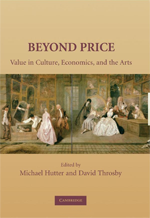Conceptual Art
During the 1960s, a progressive liberation of the spectator from observer to active participant occurred in the visual and performing arts, which were reciprocally informed by participatory forms of social protest and performance: marches, sit-ins, riots, and so on. Dancer and choreographer Anna Halprin (née Ann Schuman, 1920–), with her San Francisco Dancers’ Workshop, was directly involved in these developments, and their experiments soon infiltrated the creative endeavors of her husband, landscape architect Lawrence Halprin (1916–2009).
Read More...At October’s GIA preconference “Measuring Impact and Translating Value: Support for Individual Artists,” more than six dozen funders convened to share their experiences supporting individual artists and to ponder how to gauge and communicate the results. The Jerome Foundation’s Eleanor Savage and Tucson Pima Arts Council’s Roberto Bedoya shepherded an agenda that included five artists speaking about their work and careers.
Read More...January 2010, 21 pages. Fine Arts Fund, 20 East Central Parkway, Suite 200, Cincinnati, OH, 45202, 513-871-2787, www.fineartsfund.org
Supporters of the arts have struggled to develop a national conversation that makes the case for robust, ongoing public support for the arts; but public spending on the arts is too often criticized as an example of wasteful government spending or a misguided government intrusion into an area where it does not belong.
Read More...
Beyond Price: Value in Culture, Economics, and the Arts; Edited by Michael Hutter and David Throsby; Cambridge University Press, 2007, 324 pages
— Lewis Hyde
Recent studies on New York’s creative sector have established that the arts are a key asset in the city’s economic portfolio. Culture Counts: Strategies for a More Vibrant Cultural Life for New York City (2001); Creative New York (2005); and The Arts as an Industry: Their Economic Impact on New York City and New York State (2007) provide ample evidence that the diverse number of cultural institutions, arts-related businesses, and artists in New York generate employment, attract tourism, and enhance the city’s quality of life.
Read More...Before the house lights dim at a production of Romeo and Juliet, I look for myself and I am delighted to find myself as I was many years ago: A teenaged boy sitting by himself. I recognize him because he keeps checking the number on his ticket against the number on the armrest. All in all, he is pleased with his seat. He wears a sweater and tie. He reads his program with the intensity I used similarly to scrutinize the actors’ biographies, the director’s notes, and the advertisements for after-theater dining.
Read More...The current economic climate has forced many nonprofit arts organizations to confront underlying issues. Tensions mount, dollars are scarce, and unresolved weaknesses or fissures often grow. We have seen heartening examples of artists, donors, audiences, and funders rallying to support the art and organizations that they love. In some cases, streamlined, more focused organizations are forging ahead with renewed determination. But in other cases, the economic downturn may herald the time to close the doors.
Read More...This arts and culture grantmaking case study is among the latest in a series of Diversity in Philanthropy Project (DPP) reports that examine how foundations can more effectively achieve excellence in various social, economic, and cultural investment arenas by expanding their focus on diversity and inclusivity.
Read More...Brooklyn, NY - National Endowment for the Arts Chairman Rocco Landesman delivered a keynote address today to close the 2009 national Grantmakers in the Arts conference: Navigating the Art of Change.
In his remarks, Chairman Landesman laid out the guiding principle that will inform his work at the agency, which can be summed up in two words: "Art works." Chairman Landesman explained that he means this in three ways:
